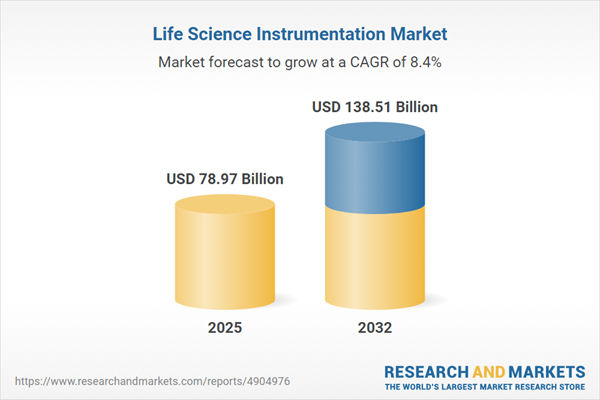Speak directly to the analyst to clarify any post sales queries you may have.
The life science instrumentation market is entering a pivotal phase as laboratories worldwide accelerate adoption of automation and digital technologies to advance operational precision, data integrity, and regulatory alignment. Senior decision-makers face complex choices regarding technology investments, supplier relationships, and future-proofing their research and development operations.
Market Snapshot: Life Science Instrumentation Market
The global life science instrumentation market reached USD 72.80 billion, is projected to achieve USD 78.97 billion by 2025, and is anticipated to attain USD 138.51 billion by 2032, reflecting a CAGR of 8.37%. This sustained growth is driven by increased uptake of advanced analytical instruments and broader implementation of laboratory automation. Pharmaceutical companies, contract research organizations, and academic institutions are prioritizing modernization efforts, with a focus on integrating digital tools that encourage scientific advancements, drive operational streamlining, and uphold more rigorous compliance in regulated sectors.
Scope & Segmentation of the Life Science Instrumentation Market
- Product Type: Laboratory instrumentation innovations support precision research, optimize diagnostic workflows, and drive process efficiency, contributing to higher accuracy and productivity.
- Cell Analysis Instruments: Flow cytometers and imaging devices enable reliable diagnostics and comparative studies in biotech and life sciences, driving new insights and applications.
- Chromatography Systems: Gas and liquid chromatography platforms are integral to quality assurance and robust analytics, aiding compliance for pharmaceutical and chemical laboratories.
- Electrophoresis Systems: Gel and capillary electrophoresis technologies maintain workflow consistency and deliver dependable results for genomics and proteomics research.
- PCR Systems: Advanced polymerase chain reaction equipment addresses evolving needs in genetic, clinical, and forensic applications with precise analytical capabilities.
- Sequencing Instruments: First- and next-generation sequencing platforms fuel genomic discovery efforts and support the advancement of personalized healthcare research.
- Spectroscopy Instruments: Mass spectrometry, nuclear magnetic resonance, and related systems provide critical molecular insights, supporting compliance and technical performance expectations.
- Application Areas: Instrumentation serves academic R&D, pharmaceutical development, diagnostics, environmental monitoring, and food safety, covering varied laboratory applications.
- Clinical Diagnostics: Instruments facilitate disease detection, enable complex data analysis, and support personalized medicine within modern healthcare delivery.
- Environmental Testing: Equipment ensures comprehensive monitoring of air, water, and soil, helping laboratories maintain environmental standards and compliance.
- Food and Beverage Testing: Solutions enable reliable quality control and traceability across the food supply chain, supporting industry standards.
- Distribution Channels: Direct sales, digital procurement, and strategic partnerships ensure scalable, adaptable laboratory access for global end-users.
- Regional Coverage: Procurement dynamics and adoption patterns respond to regulatory differences across North America, South America, Europe, the Middle East & Africa, and Asia-Pacific, shaping market entry and expansion strategies.
Key Takeaways: Strategic Insights for Decision-Makers
- Laboratory automation and artificial intelligence are transforming operational models, increasing process reliability and reducing manual intervention risks.
- Cloud-based analytics enhance laboratory connectivity, offering transparency and streamlined compliance management, especially in multi-site operations.
- Modular system designs facilitate integration, enabling cross-team project collaboration and greater scalability for evolving research goals.
- Microfluidic technologies accelerate sample processing, allowing laboratories to quickly adapt to changing diagnostic and research requirements.
- Flexible procurement and supply chain solutions help organizations respond to market and operational shifts, increasing continuity during periods of disruption.
- Regional regulations and procurement guidelines require tailored strategies to ensure sustainable growth and effective geographic expansion.
Tariff Impact and Supply Chain Adjustments
Recent increases in tariffs on components such as chromatography columns and specialty optics have prompted many suppliers to reassess sourcing and distribution tactics. Diversification of supplier bases and development of regional inventory hubs have emerged as risk mitigation strategies. Some organizations relocate production closer to their primary markets to further enhance supply chain resilience and adapt to a shifting regulatory and trade environment.
Methodology & Data Sources
This market analysis draws on executive interviews, practitioner feedback, and comprehensive study of procurement patterns. Findings are further validated through detailed reviews of patent records and regulatory documents, delivering substantiated recommendations for decision-makers engaged in the life science instrumentation sector.
Why This Life Science Instrumentation Market Report Matters
- Supports effective procurement and strategic investment decisions by providing targeted recommendations and in-depth segmentation analysis tailored to industry demands.
- Helps senior leaders synchronize technology planning with relevant regulatory and supply chain frameworks, supporting risk mitigation and operational flexibility.
- Equips organizations with actionable insights to bolster competitive positioning and ensure sustained operational progress in evolving markets.
Conclusion
Embracing agile technologies and forging strategic partnerships positions organizations to anticipate laboratory challenges and strengthen operational resilience. Sustained market leadership depends on a commitment to adaptation and continual innovation.
Additional Product Information:
- Purchase of this report includes 1 year online access with quarterly updates.
- This report can be updated on request. Please contact our Customer Experience team using the Ask a Question widget on our website.
Table of Contents
3. Executive Summary
4. Market Overview
7. Cumulative Impact of Artificial Intelligence 2025
Companies Mentioned
The companies profiled in this Life Science Instrumentation market report include:- Bruker Corporation
- Eppendorf SE
- Hitachi, Ltd.
- Horiba, Ltd.
- Merck KGaA
- PerkinElmer, Inc.
- Sartorius AG
- Shimadzu Corporation
- Thermo Fisher Scientific Inc.
- Waters Corporation
Table Information
| Report Attribute | Details |
|---|---|
| No. of Pages | 196 |
| Published | November 2025 |
| Forecast Period | 2025 - 2032 |
| Estimated Market Value ( USD | $ 78.97 Billion |
| Forecasted Market Value ( USD | $ 138.51 Billion |
| Compound Annual Growth Rate | 8.3% |
| Regions Covered | Global |
| No. of Companies Mentioned | 11 |









